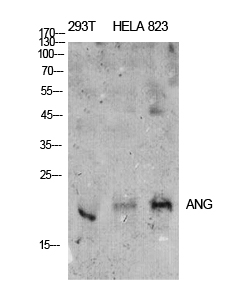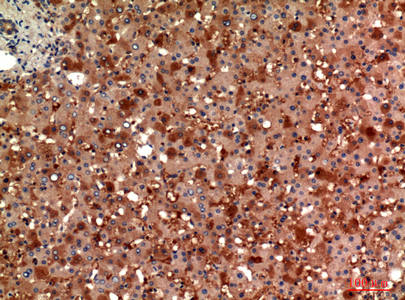ANG I Polyclonal Antibody
- Catalog No.:YT5543
- Applications:WB;IHC;IF;ELISA
- Reactivity:Human;Mouse
- Target:
- Ang-1
- Fields:
- >>Amyotrophic lateral sclerosis
- Gene Name:
- ANG
- Protein Name:
- Angiogenin
- Human Gene Id:
- 283
- Human Swiss Prot No:
- P03950
- Mouse Swiss Prot No:
- P21570
- Immunogen:
- The antiserum was produced against synthesized peptide derived from the N-terminal region of human N-ternal ANG. AA range:11-60
- Specificity:
- ANG I Polyclonal Antibody detects endogenous levels of ANG I protein.
- Formulation:
- Liquid in PBS containing 50% glycerol, 0.5% BSA and 0.02% sodium azide.
- Source:
- Polyclonal, Rabbit,IgG
- Dilution:
- WB 1:500 - 1:2000. IHC: 1:100-1:300. ELISA: 1:10000.. IF 1:50-200
- Purification:
- The antibody was affinity-purified from rabbit antiserum by affinity-chromatography using epitope-specific immunogen.
- Concentration:
- 1 mg/ml
- Storage Stability:
- -15°C to -25°C/1 year(Do not lower than -25°C)
- Other Name:
- ANG;RNASE5;Angiogenin;Ribonuclease 5;RNase 5
- Observed Band(KD):
- 17kD
- Background:
- angiogenin(ANG) Homo sapiens The protein encoded by this gene is an exceedingly potent mediator of new blood vessel formation. It hydrolyzes cellular tRNAs resulting in decreased protein synthesis and is similar to pancreatic ribonuclease. In addition, the mature peptide has antimicrobial activity against some bacteria and fungi, including S. pneumoniae and C. albicans. Alternative splicing results in two transcript variants encoding the same protein. This gene and the gene that encodes ribonuclease, RNase A family, 4 share promoters and 5' exons. Each gene splices to a unique downstream exon that contains its complete coding region. [provided by RefSeq, Aug 2014],
- Function:
- caution:It is uncertain whether Met-1 or Met-3 is the initiator.,developmental stage:Low level expression in the developing fetus, increased in the neonate, and maximal in the adult.,disease:Defects in ANG are the cause of susceptibility to amyotrophic lateral sclerosis type 9 (ALS9) [MIM:611895]. ALS is a degenerative disorder of motor neurons in the cortex, brain stem and spinal cord. ALS is characterized by muscular weakness and atrophy.,function:May function as a tRNA-specific ribonuclease that binds to actin on the surface of endothelial cells; once bound, angiogenin is endocytosed and translocated to the nucleus, thereby promoting the endothelial invasiveness necessary for blood vessel formation. Angiogenin induces vascularization of normal and malignant tissues. Abolishes protein synthesis by specifically hydrolyzing cellular tRNAs.,online information:Angiogenin,similarity:Belongs
- Subcellular Location:
- Cytoplasmic vesicle, secretory vesicle lumen . Secreted . Nucleus . Nucleus, nucleolus . Rapidly endocytosed by target cells and translocated to the nucleus where it accumulates in the nucleolus and binds to DNA (PubMed:12051708). .
- Expression:
- Expressed predominantly in the liver. Also detected in endothelial cells and spinal cord neurons.
- June 19-2018
- WESTERN IMMUNOBLOTTING PROTOCOL
- June 19-2018
- IMMUNOHISTOCHEMISTRY-PARAFFIN PROTOCOL
- June 19-2018
- IMMUNOFLUORESCENCE PROTOCOL
- September 08-2020
- FLOW-CYTOMEYRT-PROTOCOL
- May 20-2022
- Cell-Based ELISA│解您多样本WB检测之困扰
- July 13-2018
- CELL-BASED-ELISA-PROTOCOL-FOR-ACETYL-PROTEIN
- July 13-2018
- CELL-BASED-ELISA-PROTOCOL-FOR-PHOSPHO-PROTEIN
- July 13-2018
- Antibody-FAQs
- Products Images

- Western Blot analysis of 293T, Hela, 823 cells using ANG I Polyclonal Antibody. Antibody was diluted at 1:500. Secondary antibody(catalog#:RS0002) was diluted at 1:20000 cells nucleus extracted by Minute TM Cytoplasmic and Nuclear Fractionation kit (SC-003,Inventbiotech,MN,USA).

- Immunohistochemical analysis of paraffin-embedded human-liver, antibody was diluted at 1:100



